tow CITROEN C4 2019 Owners Manual
[x] Cancel search | Manufacturer: CITROEN, Model Year: 2019, Model line: C4, Model: CITROEN C4 2019Pages: 317, PDF Size: 9.31 MB
Page 5 of 317
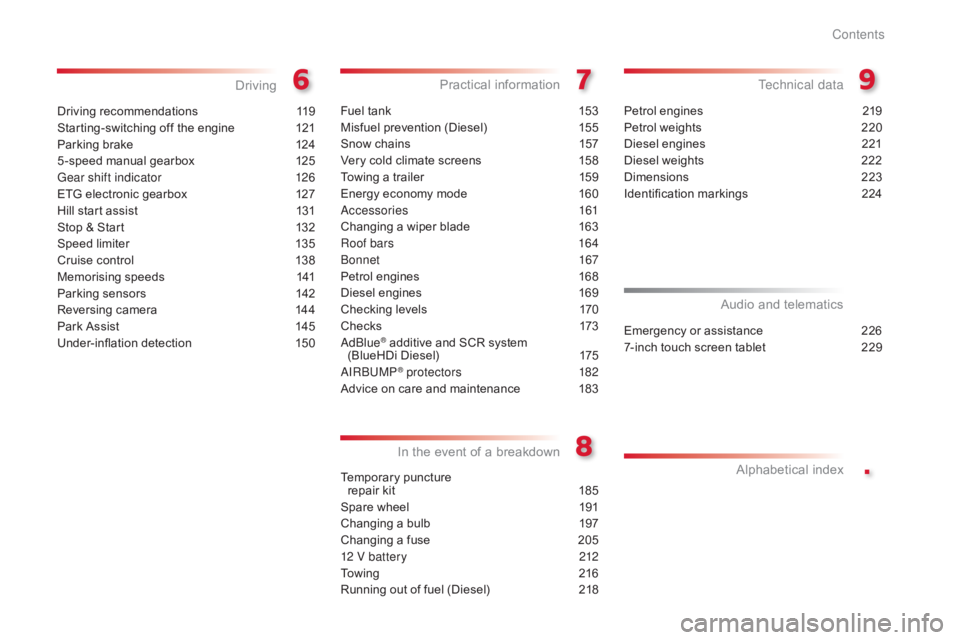
.
C4-cactus_en_Chap00a_sommaire_ed01-2016
Drivingô recommendationsô 119
Starting-switching ô off ô the ô engine ô
1
21
Parking
ô brake ô
1
24
5 -speed
ô manual ô gearbox ô
1
25
Gear shift indicator
1
26
ETG
ô electronic ô gearbox ô
1
27
Hill
ô start ô assist ô
1
31
Stop
ô & ô Start ô
1
32
Speed
ô limiter ô
1
35
Cruise
ô control ô
1
38
Memorising
ô speeds ô
1
41
Parking
ô sensors ô
1
42
Reversing
ô camera ô
1
44
Park
ô Assist ô
1
45
Under-inflation
ô d
etection
ô 1
50
Driving
Fuelô tankô 1 53
Misfuel ô prevention ô (Diesel) ô
1
55
Snow
ô chains ô
1
57
Very
ô cold ô climate ô screens ô
1
58
Towing
ô a ô trailer ô
1
59
Energy
ô economy ô mode ô
1
60
Accessories
161
Changing
ô a ô wiper ô blade ô
1
63
Roof bars
1
64
Bonnet
167
Petrol
ô engines ô
1
68
Diesel
ô engines ô
1
69
Checking
ô levels ô
1
70
Checks
ô 1
73
AdBlue
ôÛô additiveô andô SCRô systemô
(
BlueHDi ô Diesel) ô 1 75
AIRBUMP
ôÛ protectors 1 82
Advice
ô
on
ô
care ô and ô maintenance ô
1
83
Practicalô information
Temporaryô punctureô
r epair ô kit ô 1 85
Spare
ô wheel ô
1
91
Changing
ô a ô bulb ô
1
97
Changing
ô a ô fuse ô
2
05
12 V battery
2
12
To w i n g
ô 2
16
Running
ô out ô of ô fuel ô (Diesel) ô
2
18
Inô theô event ô o f ô a ô b reakdown
Petrolô enginesô 2 19
Petrol ô weights ô
2
20
Diesel
ô engines ô
2
21
Diesel
ô weights ô
2
22
Dimensions
ô 2
23
Identification
ô ma
rkings
ô 2
24
Technical data
Emergencyô orô assistanceô 226
7-inch ô touch ô screen ô tablet ô
2
29
Audioô andô telematics
Alphabetical
ô in
dex
Contents
Page 6 of 317
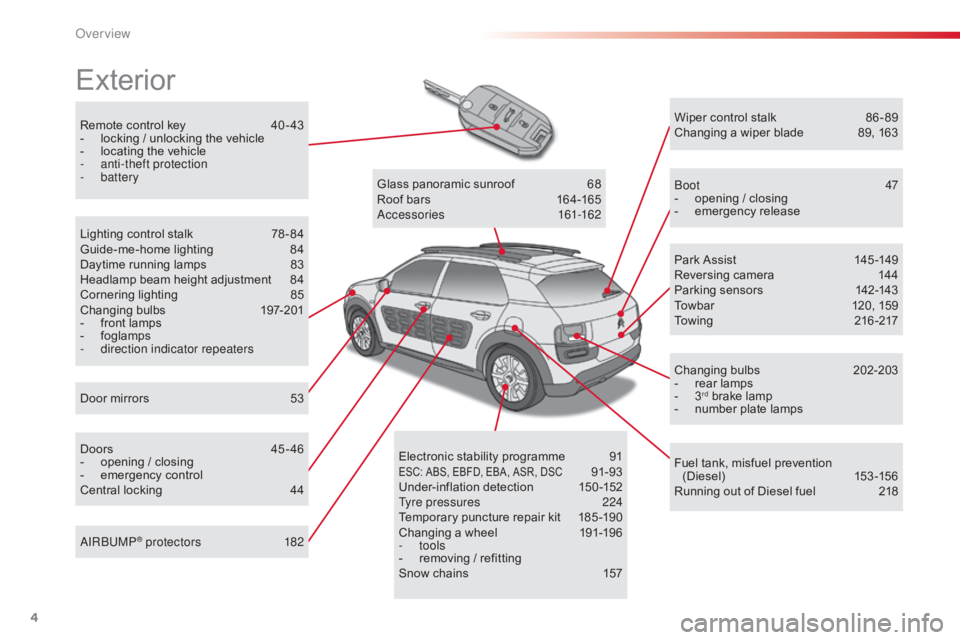
4
C4-cactus_en_Chap00b_vue-ensemble_ed01-2016
Remoteô controlô keyô 40 - 43
- ô l ocking ô / ô unlocking ô the ô vehicle
-
ô
l
ocating ô the ô vehicle
-
a
nti-theft protection
-
battery
Exterior
Doorô mirrorsô 5 3
Lighting ô control ô stalk ô
7
8 - 84
Guide-me-home ô lighting ô
8
4
Daytime ô running ô lamps ô
8
3
Headlamp ô beam ô height ô adjustment ô
8
4
Cornering ô lighting ô
8
5
Changing
ô bu
lbs
ô 1
97-201
- ô
f
ront ô lamps
-
ô fo
glamps
-
d
irection indicator repeaters
Doors ô
4
5 - 46
-
ô
o
pening ô / ô closing
-
ô em
ergency
ô c
ontrol
Central
ô locking ô
4
4Glass
ô panoramic ô sunroof ô
6
8
Roof ô bars ô
1
64-165
Accessories
1
61-162
Wiper ô control ô stalk ô
8
6 - 89
Changing ô a ô wiper ô blade ô
8
9, ô 163
Boot
47
- ô
o
pening ô / ô closing
-
ô em
ergency
ô r
elease
Park ô Assist ô
1
45 -149
Reversing ô camera ô
1
44
Parking ô sensors ô
1
42-143
Towbar ô
1
20, ô 159
Towing
ô 21
6 -217
Changing
ô bu
lbs
ô 2
02-203
- ô r ear ô lamps
- ô 3rdô brakeô lamp
-
ô n
umber ô plate ô lamps
Fuel
ô
tank, ô misfuel ô prevention ô
(
Diesel)
ô 15
3 -15 6
Running
ô out ô of ô Diesel ô fuel ô
2
18
Electronic
ô s
tability
ô pro
gramme
ô 9
1
ESC:ô ABS,ô EBFD,ô EBA,ô ASR,ô DSCô 91-93
Under-inflationô d
etectionô 1 50-152
Tyre pressures
2
24
Temporary
ô
puncture
ô
repair
ô
kit
ô
1
85 -190
Changing
ô
a
ô
wheel
ô
1
91-196
-
tools
-
ô
r
emoving
ô
/
ô
refitting
Snow
ô
chains
ô
1
57
AIRBUMP
ôÛ protectors 1
82
Over view
Page 11 of 317
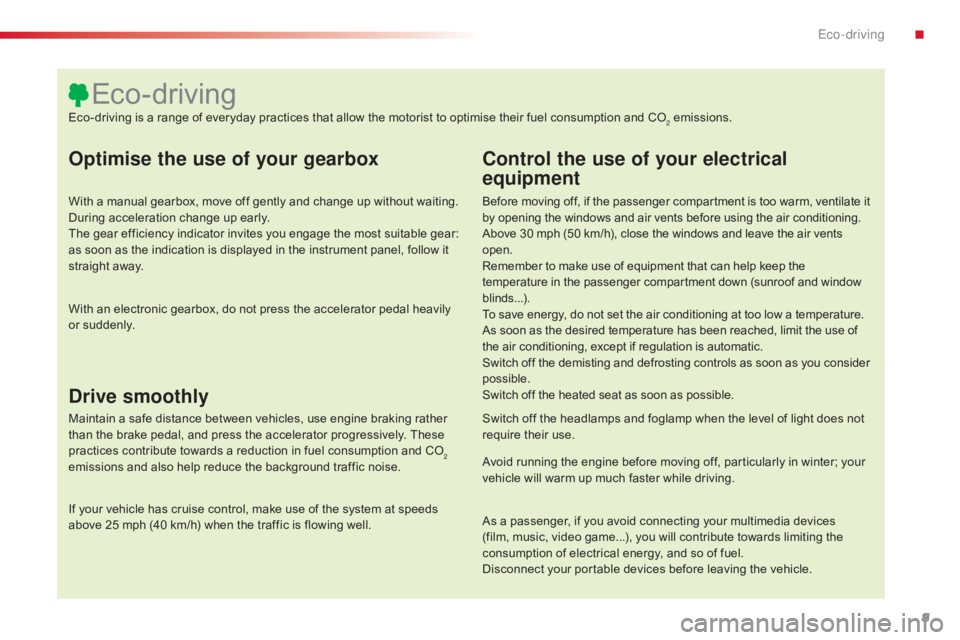
9
C4-cactus_en_Chap00c_eco-conduite_ed01-2016
Optimise the use of your gearbox
Withô aô manualô gearbox,ô moveô offô gentlyô andô changeô upô withoutô waiting.ô During ô acceleration ô change ô up ô early.
The
ô gear ô efficiency ô indicator ô invites ô you ô engage ô the ô most ô suitable ô gear: ô
a
s ô soon ô as ô the ô indication ô is ô displayed ô in ô the ô instrument ô panel, ô follow ô it ô
s
traight ô away.
Control the use of your electrical
equipment
Beforeô movingô off,ô ifô theô passengerô compartmentô isô tooô warm,ô ventilateô itô by ô opening ô the ô windows ô and ô air ô vents ô before ô using ô the ô air ô conditioning.
Above
ô 30 ô mph ô (50 ô km/h), ô close ô the ô windows ô and ô leave ô the ô air ô vents
ô ope
n.
Remember
ô to ô make ô use ô of ô equipment ô that ô can ô help ô keep ô the
ô t
emperature ô in ô the ô passenger ô compartment ô down ô (sunroof ô and ô window
ô b
linds...).
To
ô save ô energy, ô do ô not ô set ô the ô air ô conditioning ô at ô too ô low ô a ô temperature.
As
ô soon ô as ô the ô desired ô temperature ô has ô been ô reached, ô limit ô the ô use ô of
ô t
he ô air ô conditioning, ô except ô if ô regulation ô is ô automatic.
Switch
ô off ô the ô demisting ô and ô defrosting ô controls ô as ô soon ô as ô you ô consider
ô p
ossible.
Switch
ô off ô the ô heated ô seat ô as ô soon ô as ô possible.
Switch
ô off ô the ô headlamps ô and ô foglamp ô when ô the ô level ô of ô light ô does ô not ô
r
equire ô their ô use.
Avoid
ô running ô the ô engine ô before ô moving ô off, ô particularly ô in ô winter; ô your ô
v
ehicle ô will ô warm ô up ô much ô faster ô while ô driving.
As
ô a ô passenger, ô if ô you ô avoid ô connecting ô your ô multimedia ô devices ô
(
film, ô music, ô video ô game...), ô you ô will ô contribute ô towards ô limiting ô the ô
c
onsumption ô of ô electrical ô energy, ô and ô so ô of ô fuel.
Disconnect
ô your ô portable ô devices ô before ô leaving ô the ô vehicle.
Eco-driving
Eco-drivingô isô aô rangeô ofô everydayô practicesô thatô allowô theô motoristô toô optimiseô theirô fuelô consumptionô andô CO2ô emissions.
With
ô
an
ô
electronic
ô
gearbox,
ô
do
ô
not
ô
press
ô
the
ô
accelerator
ô
pedal
ô
heavily
ô
o
r
ô s
uddenly.
Drive smoothly
Maintainô aô safeô distanceô betweenô vehicles,ô useô engineô brakingô ratherô t han ô the ô brake ô pedal, ô and ô press ô the ô accelerator ô progressively. ô These ô
p
ractices ô contribute ô towards ô a ô reduction ô in ô fuel ô consumption ô and ô CO
2
emissions
ô
and
ô
also
ô
help
ô
reduce
ô
the
ô
background
ô
traffic
ô
noise.
If
ô
your
ô
vehicle
ô
has
ô
cruise
ô
control,
ô
make
ô
use
ô
of
ô
the
ô
system
ô
at
ô
speeds
ô
a
bove
ô
25
ô
mph
ô
(40
ô
km/h)
ô
when
ô
the
ô
traffic
ô
is
ô
flowing
ô
well.
.
Eco-driving
Page 15 of 317
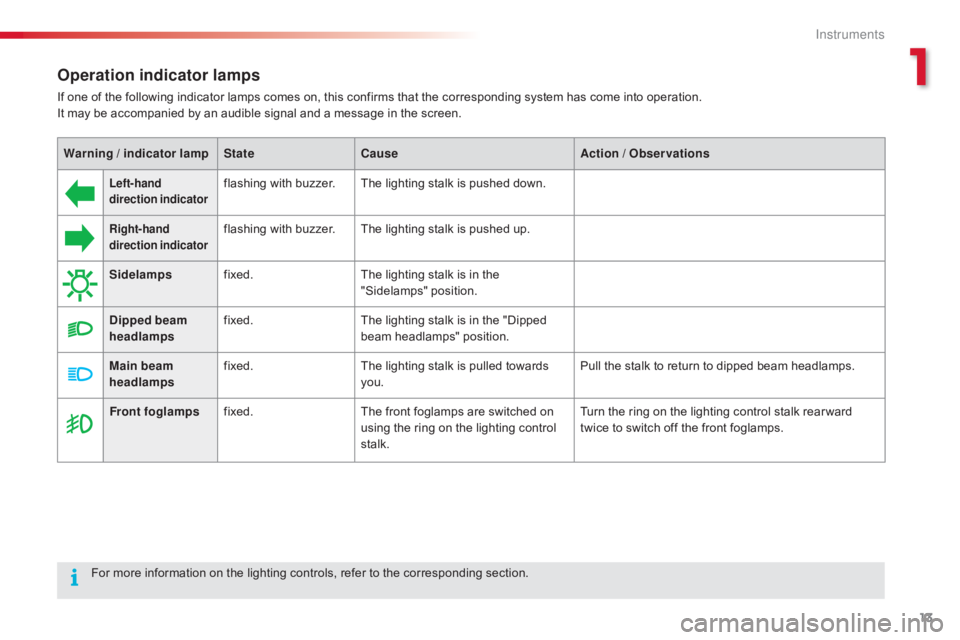
13
C4-cactus_en_Chap01_Instruments-de-bord_ed01-2016
Operation indicator lamps
Ifô oneô ofô theô followingô indicatorô lampsô comesô on,ô thisô confirmsô thatô theô correspondingô systemô hasô comeô intoô operation.
I t ô may ô be ô accompanied ô by ô an ô audible ô signal ô and ô a ô message ô in ô the ô screen.
Left-hand
direction indicatorflashingô withô buzzer.The ô lighting ô stalk ô is ô pushed ô down.
Right-hand
direction indicatorflashingô withô buzzer.The ô lighting ô stalk ô is ô pushed ô up.
Sidelamps fixed. The
ô lighting ô stalk ô is ô in ô the ô
"
Sidelamps"
ô p
osition.
Dipped beam
headlamps fixed.
The
ô lighting ô stalk ô is ô in ô the ô "Dipped ô
b
eam ô headlamps" ô position.
Main beam
headlamps fixed.
The
ô lighting ô stalk ô is ô pulled ô towards ô
yo
u. Pull
ô the ô stalk ô to ô return ô to ô dipped ô beam ô headlamps.
Front foglamps fixed. The
ô front ô foglamps ô are ô switched ô on ô
u
sing ô the ô ring ô on ô the ô lighting ô control ô
st
alk. Turn
ô the ô ring ô on ô the ô lighting ô control ô stalk ô rear ward ô
t
wice ô to ô switch ô off ô the ô front ô foglamps.
For
ô
more
ô
information
ô
on
ô the ô lighting ô controls, ô refer ô to ô the ô corresponding ô section.
Warning / indicator lamp
StateCause Action / Observations
1
Instruments
Page 23 of 317
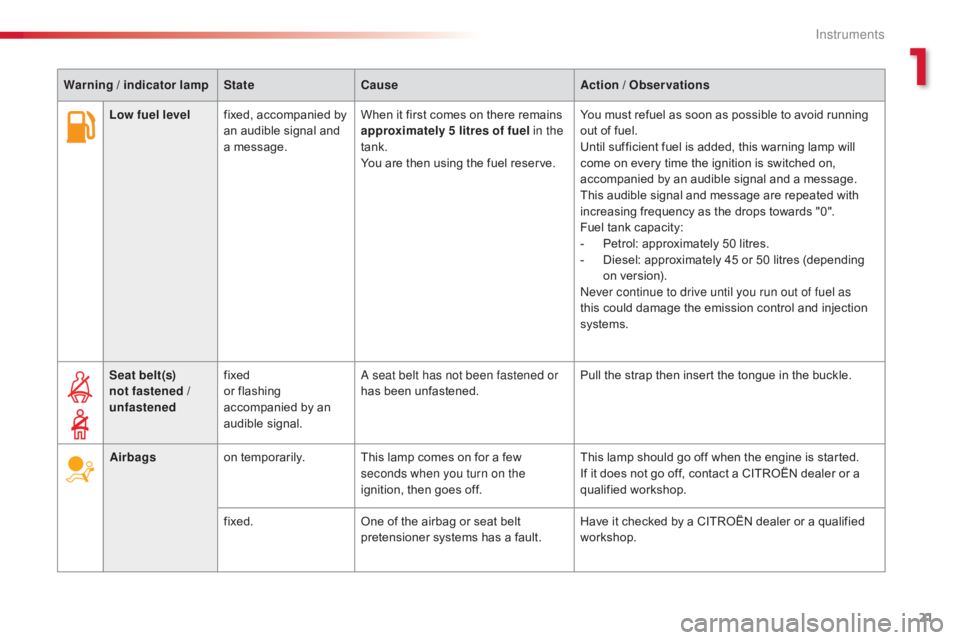
21
C4-cactus_en_Chap01_Instruments-de-bord_ed01-2016
Low fuel levelfixed, ô accompanied ô by ô a
n ô audible ô signal ô and ô
a
ô message. When
ô it ô first ô comes ô on ô there ô remains ô a
pproximately 5 litres of fuel in the
tank.
You
ô are ô then ô using ô the ô fuel ô reserve.You
ô must ô refuel ô as ô soon ô as ô possible ô to ô avoid ô running ô o
ut ô of ô fuel.
Until
ô sufficient ô fuel ô is ô added, ô this ô warning ô lamp ô will ô
c
ome ô on ô every ô time ô the ô ignition ô is ô switched ô on, ô
a
ccompanied ô by ô an ô audible ô signal ô and ô a ô message.
This
ô audible ô signal ô and ô message ô are ô repeated ô with ô
i
ncreasing ô frequency ô as ô the ô drops ô towards ô "0".
Fuel
ô t
ank
ô c
apacity:
-
ô
Pe
trol: ô approximately ô 50 ô litres.
-
ô
D
iesel: ô approximately ô 45 ô or ô 50 ô litres ô (depending ô
o
n ô version).
Never continue to drive until you run out of fuel as
this
ô could ô damage ô the ô emission ô control ô and ô injection ô
s
ystems.
Seat belt(s)
not fastened /
unfastened fixed
or
ô flashing ô
a
ccompanied ô by ô an ô
a
udible
ô s
ignal.A seat belt has not been fastened or
has
ô been ô unfastened.Pull
ô the ô strap ô then ô insert ô the ô tongue ô in ô the ô buckle.
Airbags on
ô temporarily. This ô lamp ô comes ô on ô for ô a ô few ô
s
econds when you turn on the
ignition,
ô then ô goes ô off.This
ô lamp ô should ô go ô off ô when ô the ô engine ô is ô started.
If
ô it ô does ô not ô go ô off, ô contact ô a ô CITROûN ô dealer ô or ô a ô
q
ualified
ô w
orkshop.
fixed. One
ô of ô the ô airbag ô or ô seat ô belt ô
p
retensioner ô systems ô has ô a ô fault.Have
ô it ô checked ô by ô a ô CITROûN ô dealer ô or ô a ô qualified ô
w
orkshop.
Warning / indicator lamp
StateCause Action / Observations
1
Instruments
Page 48 of 317
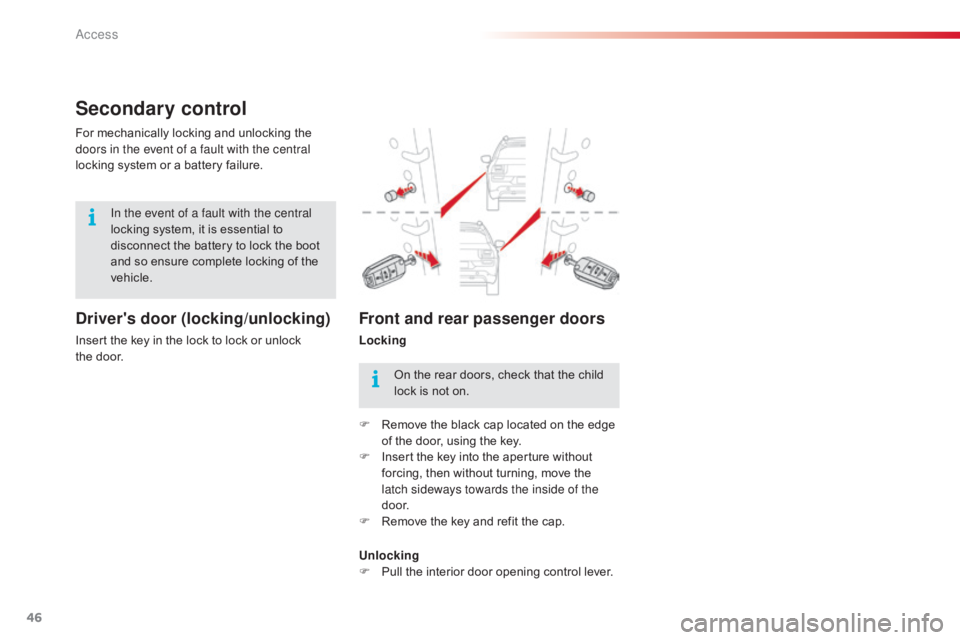
46
C4-cactus_en_Chap02_ouvertures_ed01-2016
Secondary control
Driver's door (locking/unlocking)
Insertô theô keyô inô theô lockô toô lockô orô unlockô theô door.
For
ô mechanically ô locking ô and ô unlocking ô the ô
d
oors in the event of a fault with the central
locking ô system ô or ô a ô battery ô failure.
Front and rear passenger doors
Locking
In the event of a fault with the central
locking
ô
system,
ô
it
ô
is
ô
essential
ô
to
ô
d
isconnect
ô
the
ô
battery
ô
to
ô
lock
ô
the
ô
boot
ô
a
nd
ô
so
ô
ensure
ô
complete
ô
locking
ô
of
ô
the
ô
v
ehicle.
Onô the ô rear ô doors, ô check ô that ô the ô child ô
l
ock ô is ô not ô on.
F
ô
R
emove ô the ô black ô cap ô located ô on ô the ô edge ô
o
f ô the ô door, ô using ô the ô key.
F
ô
I
nsert ô the ô key ô into ô the ô aperture ô without ô
f
orcing, ô then ô without ô turning, ô move ô the ô
l
atch sideways towards the inside of the
d o o r.
F
ô
R
emove ô the ô key ô and ô refit ô the ô cap.
Unlocking
F
ô
P
ull ô the ô interior ô door ô opening ô control ô lever.
Access
Page 54 of 317
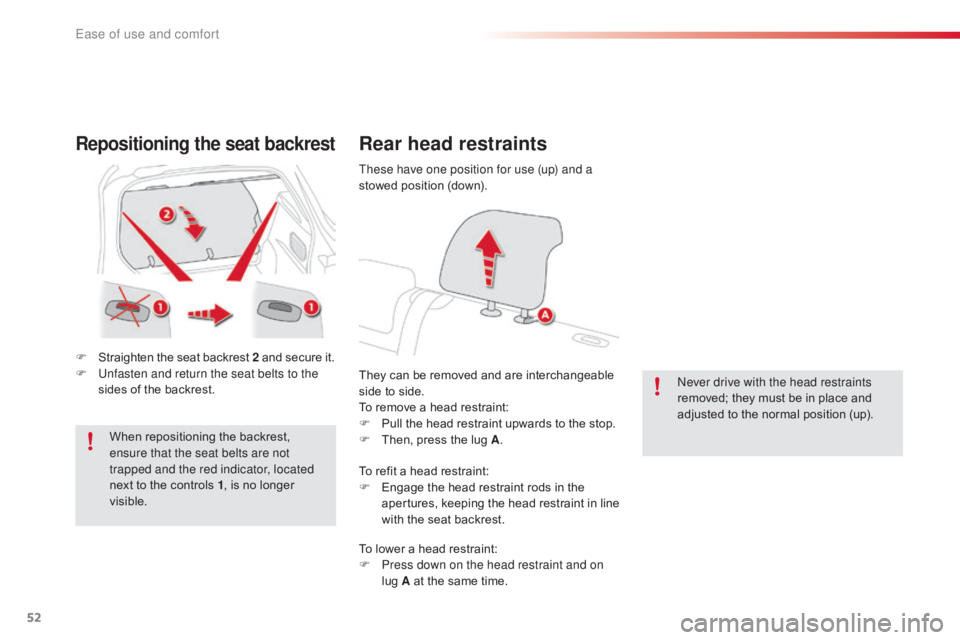
52
C4-cactus_en_Chap03_Ergonomie-et-confort_ed01-2016
Repositioning the seat backrest
Fô Straightenô the ô seat ô backrest ô 2ô and ô secure ô it.
F U nfasten and return the seat belts to the
sides
ô of ô the ô backrest.
When
ô repositioning ô the ô backrest, ô
e
nsure that the seat belts are not
trapped and the red indicator, located
next
ô to ô the ô controls ô 1,
ô is ô no ô longer ô
vis
ible.
Rear head restraints
Theyô canô beô removedô andô areô interchangeableô side ô to ô side.
To
ô remove ô a ô head ô restraint:
F
ô
P
ull ô the ô head ô restraint ô upwards ô to ô the ô stop.
F
ô
T
hen, ô press ô the ô lug ô A. Never drive with the head restraints
removed;
ô they ô must ô be ô in ô place ô and ô
a
djusted ô to ô the ô normal ô position ô (up).
These have one position for use (up) and a
stowed
ô position ô (down).
To ô refit ô a ô head ô restraint:
F
ô
E
ngage ô the ô head ô restraint ô rods ô in ô the ô
a
pertures, ô
k
eeping ô
t
he ô
h
ead ô
r
estraint ô
i
n ô
l
ine ô
w
ith ô the ô seat ô backrest.
To
ô lower ô a ô head ô restraint:
F
P
ress down on the head restraint and on
lug
ô A ô at ô the ô same ô time.
Ease of use and comfort
Page 55 of 317
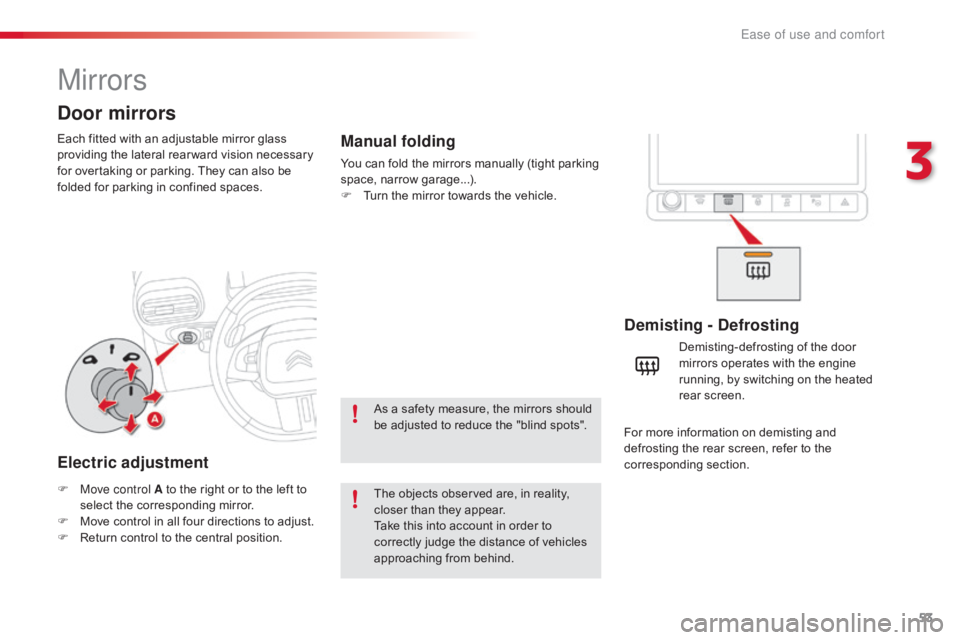
53
C4-cactus_en_Chap03_Ergonomie-et-confort_ed01-2016
Mirrors
Eachô fittedô withô anô adjustableô mirrorô glassô providing ô the ô lateral ô rear ward ô vision ô necessary ô
f
or ô overtaking ô or ô parking. ô They ô can ô also ô be ô
f
olded ô for ô parking ô in ô confined ô spaces.
Door mirrors
Demisting - Defrosting
F Move control Aô to ô the ô right ô or ô to ô the ô left ô to ô s
elect ô the ô corresponding ô mirror.
F
ô
M
ove ô control ô in ô all ô four ô directions ô to ô adjust.
F
ô
R
eturn ô control ô to ô the ô central ô position. Demisting-defrosting
ô of ô the ô door ô
m
irrors ô operates ô with ô the ô engine ô
r
unning, ô by ô switching ô on ô the ô heated ô
re
ar
ô sc
reen.
Electric adjustment
Theô objectsô observedô are,ô inô reality,ô c
loser ô than ô they ô appear.
Take
ô this ô into ô account ô in ô order ô to ô
c
orrectly ô judge ô the ô distance ô of ô vehicles ô
a
pproaching ô from ô behind.
Manual folding
Youô canô foldô theô mirrorsô manuallyô (tightô parkingô space,ô nar rowô g arage...).
F
ô
T
urn ô the ô mirror ô towards ô the ô vehicle.
As
ô a ô safety ô measure, ô the ô mirrors ô should ô
b
e ô adjusted ô to ô reduce ô the ô "blind ô spots".For
ô more ô information ô on ô demisting ô and ô
d
efrosting ô the ô rear ô screen, ô refer ô to ô the ô
c
orresponding
ô s
ection.
3
Ease of use and comfort
Page 58 of 317
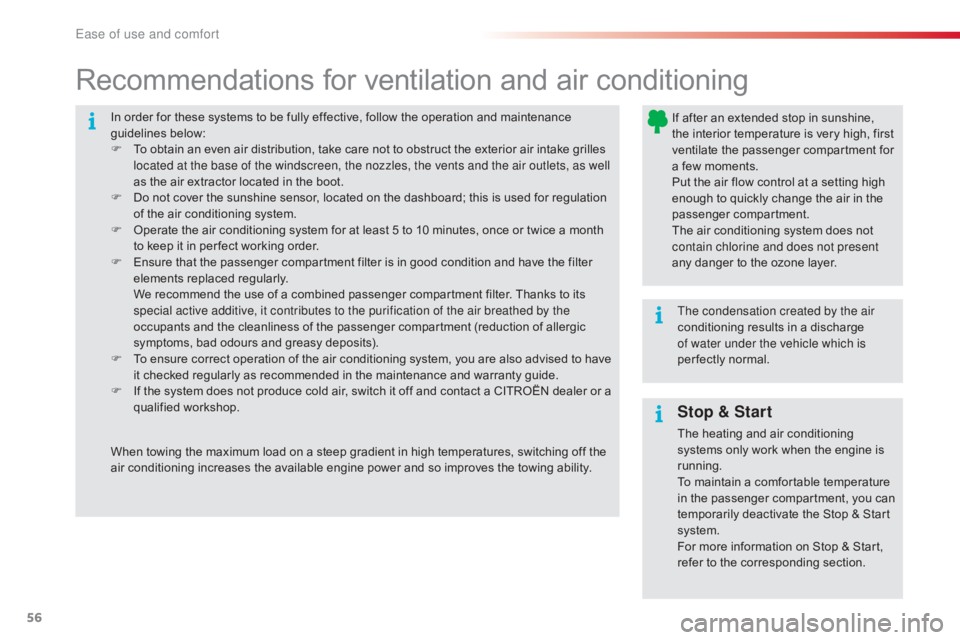
56
C4-cactus_en_Chap03_Ergonomie-et-confort_ed01-2016
Inô orderô forô theseô systemsô toô beô fullyô effective,ô followô theô operationô andô maintenanceô guidelinesô belo w:
F
ô
T
o ô obtain ô an ô even ô air ô distribution, ô take ô care ô not ô to ô obstruct ô the ô exterior ô air ô intake ô grilles ô
l
ocated at the base of the windscreen, the nozzles, the vents and the air outlets, as well
as
ô the ô air ô extractor ô located ô in ô the ô boot.
F
ô
D
o ô not ô cover ô the ô sunshine ô sensor, ô located ô on ô the ô dashboard; ô this ô is ô used ô for ô regulation ô
o
f ô the ô air ô conditioning ô system.
F
ô
O
perate ô the ô air ô conditioning ô system ô for ô at ô least ô 5 ô to ô 10 ô minutes, ô once ô or ô twice ô a ô month ô
t
o ô keep ô it ô in ô per fect ô working ô order.
F
ô
E
nsure ô that ô the ô passenger ô compartment ô filter ô is ô in ô good ô condition ô and ô have ô the ô filter ô
e
lements ô replaced ô regularly.
ô ô W
e ô recommend ô the ô use ô of ô a ô combined ô passenger ô compartment ô filter. ô Thanks ô to ô its ô
s
pecial active additive, it contributes to the purification of the air breathed by the
occupants
ô and ô the ô cleanliness ô of ô the ô passenger ô compartment ô (reduction ô of ô allergic ô
s
ymptoms, ô bad ô odours ô and ô greasy ô deposits).
F
ô
T
o ô ensure ô correct ô operation ô of ô the ô air ô conditioning ô system, ô you ô are ô also ô advised ô to ô have ô
i
t ô checked ô regularly ô as ô recommended ô in ô the ô maintenance ô and ô warranty ô guide.
F
ô
I
f ô the ô system ô does ô not ô produce ô cold ô air, ô switch ô it ô off ô and ô contact ô a ô CITROûN ô dealer ô or ô a ô
q
ualified
ô w
orkshop.
Recommendationsô forô ventilationô andô airô conditioning
Ifô afterô anô extendedô stopô inô sunshine,ô the ô i nterior ô t emperature ô i s ô v ery ô h igh, ô f irst ô
v
entilate ô the ô passenger ô compartment ô for ô
a
ô few ô moments.
Put
ô the ô air ô flow ô control ô at ô a ô setting ô high ô
e
nough ô to ô quickly ô change ô the ô air ô in ô the ô
p
assenger
ô c
ompartment.
The
ô air ô conditioning ô system ô does ô not ô
c
ontain chlorine and does not present
any
ô danger ô to ô the ô ozone ô layer.
The condensation created by the air
conditioning
ô results ô in ô a ô discharge ô
o
f water under the vehicle which is
per fectly
ô normal.
When
ô
towing
ô
the
ô
maximum
ô
load
ô
on
ô
a
ô
steep
ô
gradient
ô
in
ô
high
ô
temperatures,
ô
switching
ô
off
ô
the
ô
a
ir
ô
conditioning
ô
increases
ô
the
ô
available
ô
engine
ô
power
ô
and
ô
so
ô
improves
ô
the
ô
towing
ô
ability.
Stop & Start
Theô heatingô andô airô conditioningô s ystems ô only ô work ô when ô the ô engine ô is ô
r
unning.
To
ô maintain ô a ô comfortable ô temperature ô
i
n ô the ô passenger ô compartment, ô you ô can ô
t
emporarily ô deactivate ô the ô Stop ô & ô Start ô
s
ystem.
For
ô more ô information ô on ô Stop ô & ô Start, ô
r
efer ô to ô the ô corresponding ô section.
Ease of use and comfort
Page 67 of 317
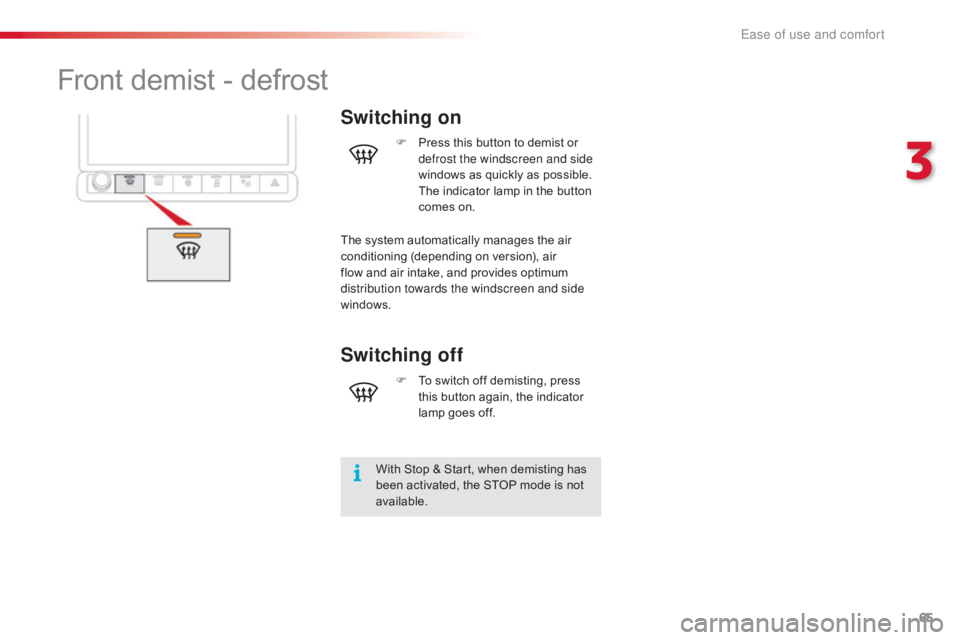
65
C4-cactus_en_Chap03_Ergonomie-et-confort_ed01-2016
Frontô demistô -ô defrost
Switching on
Withô Stopô &ô Start,ô whenô demistingô hasô been ô activated, ô the ô STOP ô mode ô is ô not ô
a
vailable. F
ô
P
ress ô this ô button ô to ô demist ô or ô
d
efrost the windscreen and side
windows ô as ô quickly ô as ô possible. ô
T
he ô indicator ô lamp ô in ô the ô button ô
c
omes ô on.
The
ô
system ô automatically ô manages ô the ô air ô
c
onditioning ô (depending ô on ô version), ô air ô
f
low
ô
and ô air ô intake, ô and ô provides ô optimum ô
d
istribution towards the windscreen and side
windows.
Switching off
Fô To ô switch ô off ô demisting, ô press ô t
his ô button ô again, ô the ô indicator ô
l
amp ô goes ô off.
3
Ease of use and comfort